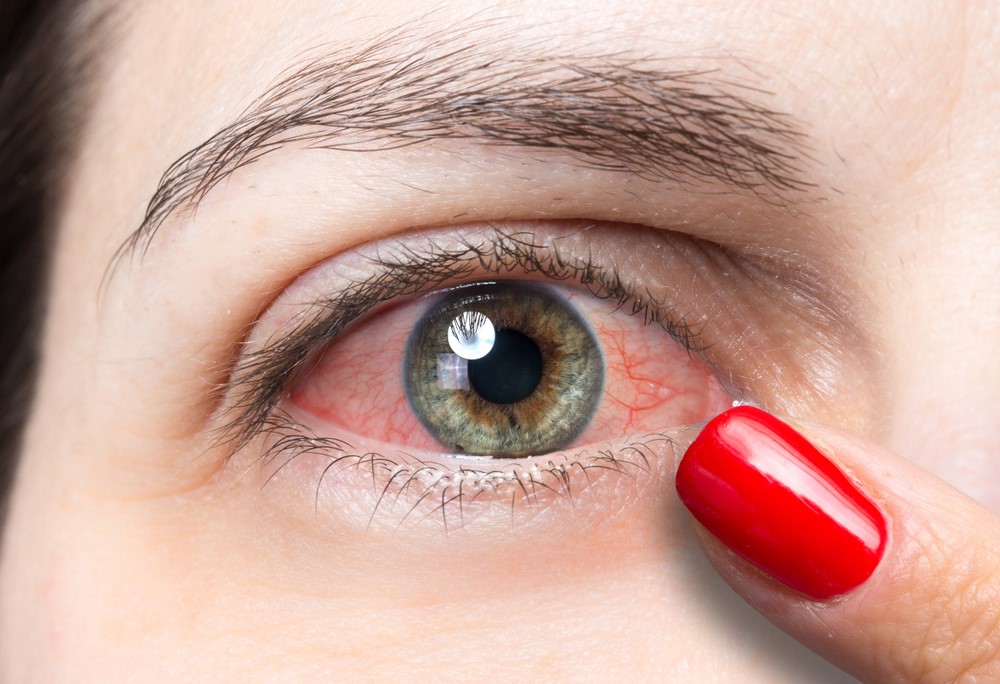Conjunctivitis
Conjunctivitis – Written by Dr. Eamonn Fahy, MB, BCh, BAO, Ph.D.
What is conjunctivitis?
Is an inflammation of the conjunctiva, which is the outer clear skin of the eye that overlies the white part of the eye. Conjunctivitis causes redness of the conjunctiva, which some refer to as ‘pink eye’. The two main causes are infections and allergies. The main infectious causes include viral and bacterial infections. Allergic conjunctivitis usually occurs in the context of hay fever (seasonal allergy causing watery eyes, runny nose, itchy throat and/or difficulty breathing).

The following sections will briefly outline the global problem of conjunctivitis, what causes conjunctivitis, its signs and symptoms, and some insights into its treatment and prevention.
The global problem of conjunctivitis
Is a very common problem. It accounts for approximately 1% of all care visits in the United States (US) and is estimated to cost the US healthcare system between US$377 and US$857 million annually.[1] Data from other healthcare settings would suggest a similar burden is present in other countries.[2]
Causes of conjunctivitis
The causes can be divided into infectious and allergic causes.
Infectious causes
Viral conjunctivitis
Is the most common type and is usually caused by a virus called ‘adenovirus’. Adenoviral conjunctivitis is very contagious and can be spread from person to person easily.
Bacterial conjunctivitis
Is the second most common type of infectious and is caused by bacteria. It is less contagious than viral conjunctivitis but can still be passed on to others.
Rarer infectious causes
- Herpes simplex virus, which also causes cold sores
- Shingles around the eye, also known as herpes zoster ophthalmicus
- Sexually transmitted infections, such as chlamydia and gonorrhea, which in some cases can be severe
Allergic causes
Is an allergic response to allergens such as pollen and animal dander. People who suffer from allergic conjunctivitis tend to also suffer from hay fever (seasonal allergy causing watery eyes, runny nose, itchy throat, and difficulty breathing) or other allergies.
What are the common signs and symptoms?

Can affect one or both eyes and its common signs and symptoms include:
- Red eyes
- Irritated, itchy, gritty eyes
- Discharge which may be watery or thick and viscous
If you experience any of these signs and symptoms, schedule an appointment with an eye health professional to get your eyes checked. It is also important to note that the development of eye conditions may even start before symptoms appear, which makes going for regular and timely eye checks that much more essential.
How can progress?
In severe cases, inflammation can have an impact on vision temporarily or permanently. For example, severe adenoviral conjunctivitis can cause scarring of the cornea (the transparent thin layer that covers the front portion of the eye), which can affect vision in some cases.
How is conjunctivitis diagnosed?
Is diagnosed by an eye care professional based on a comprehensive eye check. A slit lamp examination (microscope used to examine structures of the eye under high magnification) is used to examine the eye in detail.
An eye swab may be done to distinguish between viral and bacterial causes of conjunctivitis and to identify a specific virus or bacteria. The eye care professional will use a cotton swab to take a sample of the cells inside the eyelids and send it to a laboratory to be examined by a specialist.
How is conjunctivitis treated?
Treatment depends on the underlying cause.
Treatment for viral conjunctivitis
In most cases of viral conjunctivitis, there is no specific treatment needed for adenoviral conjunctivitis. Lubricant eye drops may be prescribed to aid with comfort. In severe cases, steroid eye drops may be prescribed as a short-term treatment.
Other rarer causes such as herpes simplex virus and shingles have specific treatments, which are dealt with by treating the cause itself.
Treatment for bacterial conjunctivitis
Antibiotic eye drops are used to treat bacterial conjunctivitis. Other rarer causes of bacterial conjunctivitis such as sexually transmitted infections usually require antibiotic tablets and eye drops used in conjunction.
Treatment for allergic conjunctivitis
- Removal of allergens: In some cases, it may be possible to avoid allergens such as animal dander. In other cases, such as hay fever, this may be more difficult.
- Eye drops: Different types of eye drops can be used to treat allergic conjunctivitis, including lubricant eye drops, and eye drops to suppress the allergic response, for example antihistamine eye drops. Sometimes, short courses of steroid eye drops may be used.
- Oral medicine: Antihistamine tablets can sometimes be used to help to reduce the allergic response in the eye.
Can be prevented?
Conjunctivitis can be prevented by avoiding contact with people who have infectious conjunctivitis. Careful hand hygiene is another important way to reduce the chance of developing infectious conjunctivitis. Allergic conjunctivitis can be prevented by avoiding the allergens as described above.
DISCLAIMER: THIS WEBSITE DOES NOT PROVIDE MEDICAL ADVICE
The information, include but not limited to, text, graphics, images and other material contained on this website are for informational purposes only. No material on this site is intended to be a substitute for professional medical advice, diagnosis or treatment. Always seek the advice of your physician or other qualified health care provider with any questions you may have regarding a medical condition or treatment and before undertaking a new healthcare regimen, and never disregard professional medical advice or delay in seeking it because of something you have read on this website.
References
- A. A. Azari and N. P. Barney, “Conjunctivitis: a systematic review of diagnosis and treatment,” JAMA, vol. 310, no. 16, pp 1721-9, Oct 2013, doi: 10.1001/jama.2013.280318.
- J. Jefferis et al., “Acute infective conjunctivitis in primary care: who needs antibiotics? An individual patient data meta-analysis,” Br J Gen Pract, vol. 61, no. 590, pp. 542-8, Sep 2011, doi: 10.3399/bjgp11X593811
Tools Designed for Healthier Eyes
Explore our specifically designed products and services backed by eye health professionals to help keep your children safe online and their eyes healthy.
